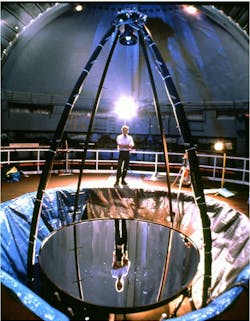Honeywell moves to next phase of developing liquid mirror technology for powerful astronomy telescopes
ARLINGTON, Va. – U.S. military researchers needed a size-scalable liquid mirror for space and ground telescope applications. They found a solution from Honeywell Aerospace Technologies in Phoenix.
Officials of the U.S. Defense Advanced Research Projects Agency (DARPA) in Arlington, Va., announced a $7.9 million contract earlier this month for the second phase of the Zenith program.
Liquid mirror telescope
Zenith seeks to develop a telescope's liquid mirror that can maintain its shape even if tilted out-of-plane. A liquid mirror is a reflecting surface created by spinning a shallow dish of a reflective liquid, like mercury to form a parabolic shape.
Liquid mirrors are for liquid-mirror telescopes that are less expensive than glass mirrors, can adapt their shape, and forms a parabolic shape, which is ideal for focusing light.
Related: Astronomers need adaptive optics for 30-meter telescope
Zenith seeks to create liquid mirrors that re tiltable, scalable, damage-resilient, suitable for space and ground telescopes, and require no motion to operate in monolithic and segmented designs.
DARPA began the 50-month Zenith program in January 2023. Its first phase sought to design a scalable liquid mirror lens, with material development and field control, to enable a 0.5-meter diameter liquid mirror lens with out-of-plane tip and tilt angles larger than 10; a 1-degree slew rate; and wavefront control correctable to 550 nanometers.
Technology demonstrations
Now Honeywell will tackle the program's second phase, which is to demonstrate the first-phase design with fluid component reflectivity of greater than 0.65; an aperture size of 3 meters in diameter; out-of-plane tip and tilt angles of greater than 25 degrees; 3-degree-per-second slew rate; wavefront control correctable to 550 nanometers; and fluid of greater than 0.65.
Astronomers today are limited by the size and costs of available telescope optics; as the primary optics get larger, their cost grows exponentially. Space-based mirrors, in addition, are vulnerable to catastrophic damage from hypervelocity space debris.
Related: Northrop Grumman tests software for Webb Space Telescope
Today’s liquid mirror telescopes are easier to build, less expensive, and are more damage-resistant than traditional glass telescopes. The Zenith program is developing modeling tools, materials, surface and field controls sufficient to demonstrate a 2-meter-diameter liquid mirror telescope and a 1 meter diameter segmented liquid mirror.
If successful, Zenith can result in liquid mirrors and liquid mirror telescopes for astronomy that behave like traditional point-and-slew telescopes, at significantly larger aperture sizes, and have applicability to ground and space applications.
On this contract Honeywell will do the work in Avon, N.Y.; Des Plaines, Ill.; Atlanta; Phoenix; and in Cambridge and Ottawa, Ontario, and should be finished by November 2026. For more information contact Honeywell Aerospace Technologies online at https://aerospace.honeywell.com, or DARPA at https://www.darpa.mil/program/zenith.
About the Author
John Keller
Editor-in-Chief
John Keller is the Editor-in-Chief, Military & Aerospace Electronics Magazine--provides extensive coverage and analysis of enabling electronics and optoelectronic technologies in military, space and commercial aviation applications. John has been a member of the Military & Aerospace Electronics staff since 1989 and chief editor since 1995.

